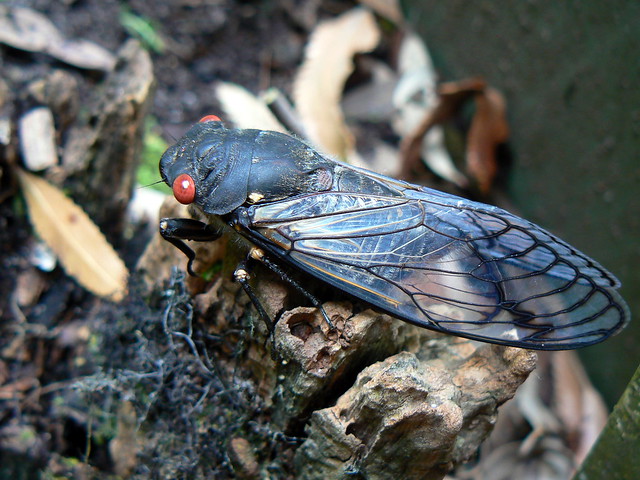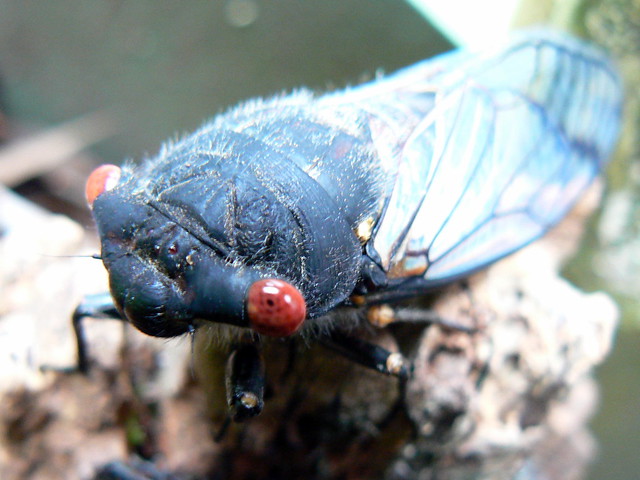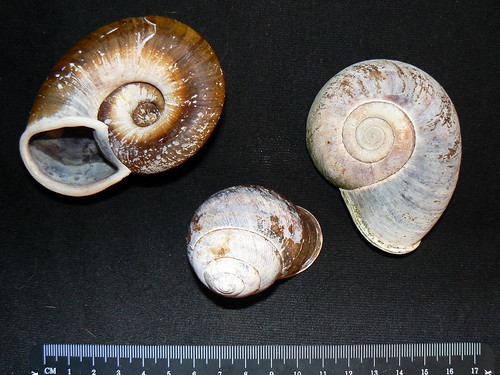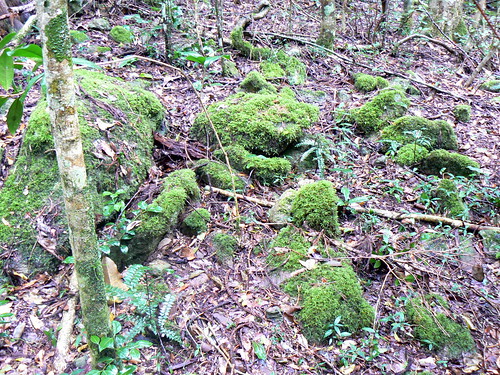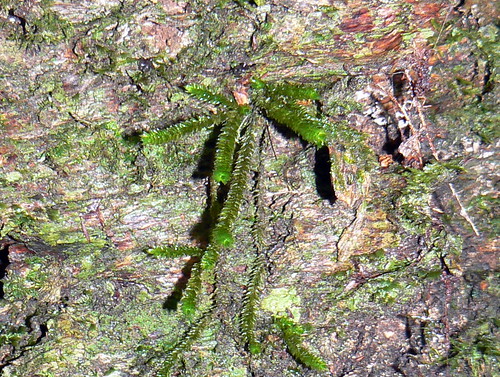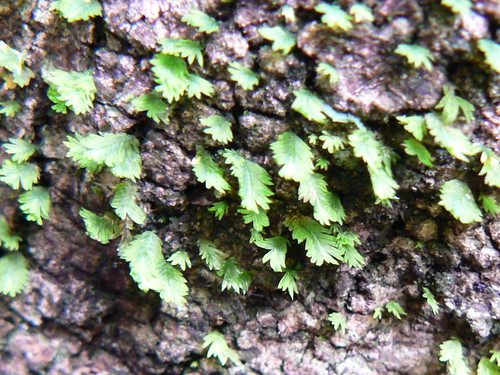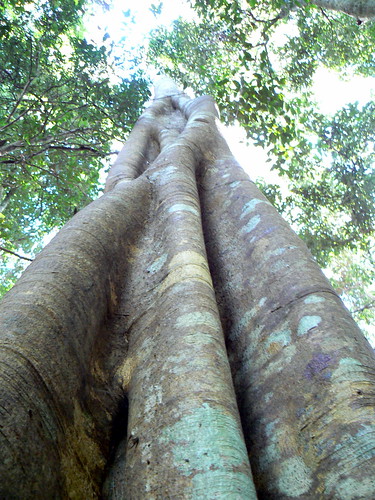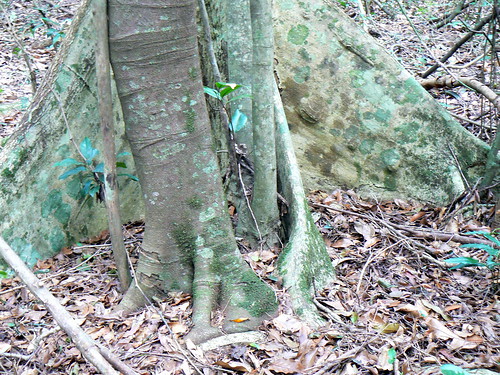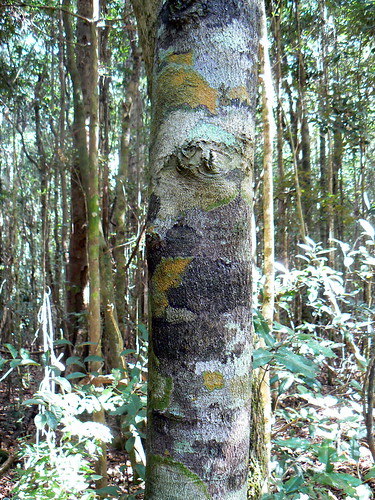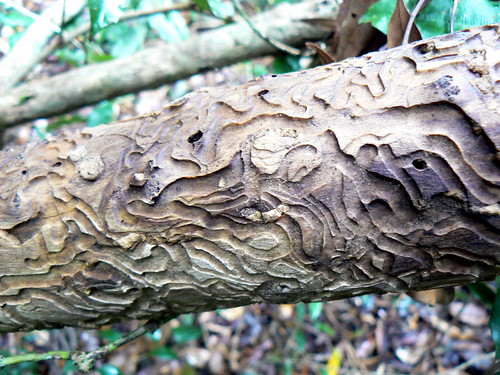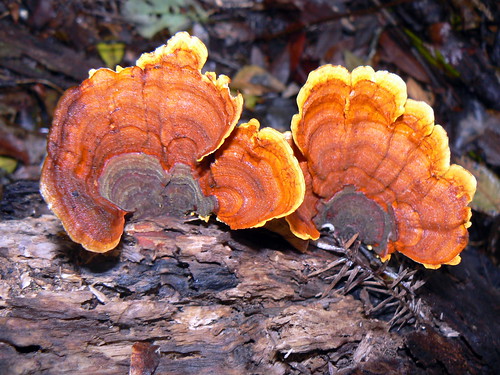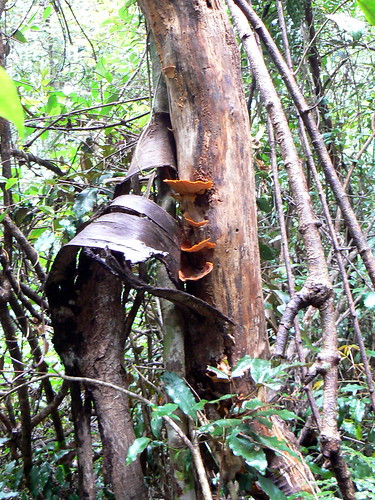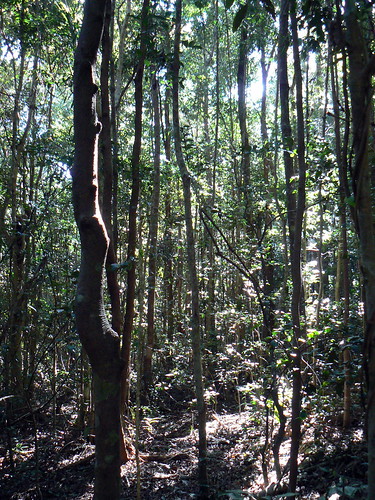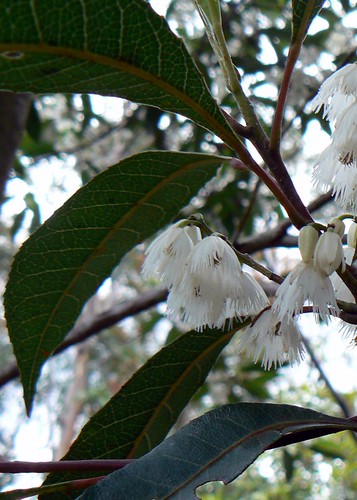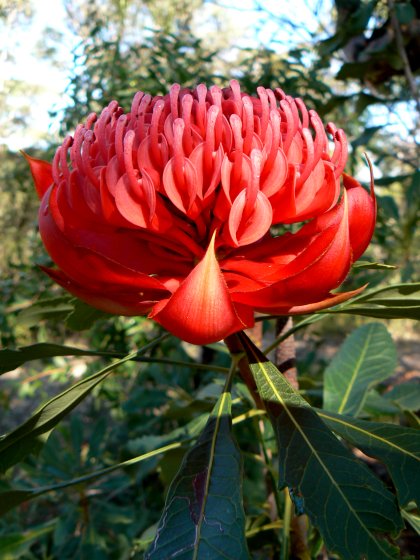Was just weeding in the garden, and encountered this, recently emerged from its shell: Psaltoda morens, the redeye cicada.
Tuesday, December 28, 2010
Ceratopetalum gummiferum: New South Wales Christmas Bush
Dotted through bushland in summer in Sydney is the New South Wales Christmas Bush, Ceratapetalum gummiferum, its distinctive red colouring contrasting with the greens of foliage and whites of Eucalypt flowers. It's frequently cultivated, and many people decorate their houses at Christmas with sprays of it.
The red comes not from the flower petals though, but from the sepals. The small white flowers emerge in spring, but as the flowers begin to fruit, they fall off and the sepals elongate and turn red.
Our front verandah is one of my favourite spots to sit and read, or just to gaze out at the birds and the plants. The changing palette of the Christmas Bush adds to the appeal.
Have a great summer (or winter!) celebration, and I hope the new year brings you happiness and good health.
The red comes not from the flower petals though, but from the sepals. The small white flowers emerge in spring, but as the flowers begin to fruit, they fall off and the sepals elongate and turn red.
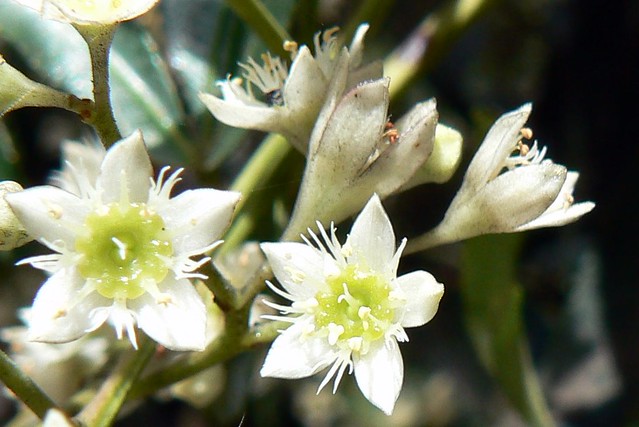 |
| Flowers in spring |
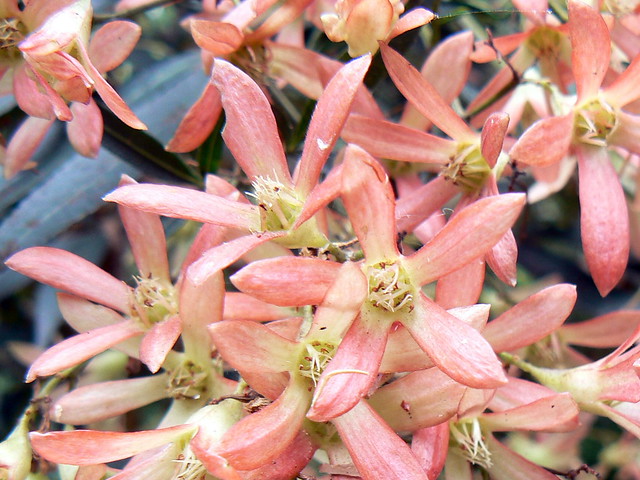 |
| Flowers in summer |
Our front verandah is one of my favourite spots to sit and read, or just to gaze out at the birds and the plants. The changing palette of the Christmas Bush adds to the appeal.
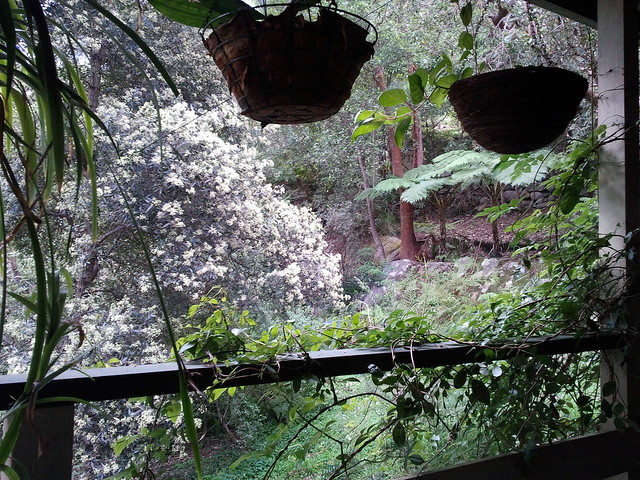 |
| Spring |
 |
| Summer |
Have a great summer (or winter!) celebration, and I hope the new year brings you happiness and good health.
Friday, November 26, 2010
Monday, November 15, 2010
Déjà Vu....
Three years ago, an Angophora costata landed on our roof during heavy rain. It's happened again, but this time it's a Corymbia gummifera. Once again, I'm waiting for the State Emergency Service to arrive with a tarpaulin. Lesson: don't grow large trees on rock platforms. :/
Heavy rain brings down trees that are poorly rooted. And it brings leeches. This afternoon, I was sitting at my desk writing a paper on symbiosis, mutualism and parasitism, and what should I see on my desk? This little creature, reading all about itself. But no pseudoreciprocity for it.
Heavy rain brings down trees that are poorly rooted. And it brings leeches. This afternoon, I was sitting at my desk writing a paper on symbiosis, mutualism and parasitism, and what should I see on my desk? This little creature, reading all about itself. But no pseudoreciprocity for it.
UPDATE: No damage to the roof tiles, I'm happy to report! The verandah awning took most of the brunt, but there is no visible buckling. Huzzah!
Friday, November 12, 2010
Garden Census: reptiles, mammals, amphibians
Earlier, I posted the Garden Bird Census. Here are the rest of the vertebrates. I might well be missing some, since many Australian mammals are nocturnal. I've never seen an echidna in our garden, for example, but would be surprised if we had none. And of course, bats aren't always easy to spot or identify!
Reptiles:
Pseudechis porphyriacus Red-bellied Black Snake
Morelia spilota spilota Diamond Python
Dendophis punctulata Green Tree Snake
Physignathus lesueurii lesueurii Australian Water Dragon
Varanus varius Lace Monitor (Goanna)
Lampropholis guichenoti Common Garden Skink
Ctenotus taeniolatus Copper Tailed Skink
Eulamprus quoyii Eastern Water Skink
Amphibians:
Limnodynastes peronii Striped Marsh Frog
Limnodynastes tasmaniensis Spotted Marsh Frog
Crinia signifera Eastern Common Froglet
Litoria peronii Peron's Tree Frog
Litoria phyllochroa Leaf Green Tree Frog
Mammals:
Wallabia bicolor Swamp Wallaby
Trichosurus vulpecula Common Brushtail Possum
Pseudocheirus peregrinus Common Ringtail Possum
Perameles nasuta Long-nosed Bandicoot
Pteropus poliocephalus Grey-headed Flying-fox (Fruit Bat)
Reptiles:
Pseudechis porphyriacus Red-bellied Black Snake
Morelia spilota spilota Diamond Python
Dendophis punctulata Green Tree Snake
Physignathus lesueurii lesueurii Australian Water Dragon
Varanus varius Lace Monitor (Goanna)
Lampropholis guichenoti Common Garden Skink
Ctenotus taeniolatus Copper Tailed Skink
Eulamprus quoyii Eastern Water Skink
 |
| Morelia spilota spilota Diamond Python |
Amphibians:
Limnodynastes peronii Striped Marsh Frog
Limnodynastes tasmaniensis Spotted Marsh Frog
Crinia signifera Eastern Common Froglet
Litoria peronii Peron's Tree Frog
Litoria phyllochroa Leaf Green Tree Frog
 |
| Litoria phyllochroa Leaf Green Tree Frog |
Mammals:
Wallabia bicolor Swamp Wallaby
Trichosurus vulpecula Common Brushtail Possum
Pseudocheirus peregrinus Common Ringtail Possum
Perameles nasuta Long-nosed Bandicoot
Pteropus poliocephalus Grey-headed Flying-fox (Fruit Bat)
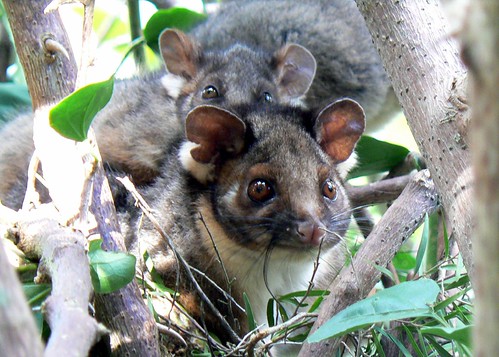 |
| Pseudocheirus peregrinus Common Ringtail Possum, mother and babies |
EDIT: A neighbour tells us that he's seen both echidnas and tiger quolls in his garden. One day, I'll construct a hide in the garden, and spend the night there with infrared glasses. Okay, maybe not. But I'd love to see them!
Garden Census: birds
Just for the fun of it, I've decided to do a census of all the vertebrates spotted (or heard!) in our garden, and in the case of some species, in the sky above our garden. I'll update these lists as I sight more.
First up, birds! I've linked each to the Australian Museum's Birds in Backyards website.
Acanthorhynchus tenuirostris Eastern Spinebill
Accipiter fasciatus Brown Goshawk
Alectura lathami Australian Brush-turkey
Alisterus scapularis Australian King-Parrot
Anthochaera carunculata Red Wattlebird
Anthochaera chrysoptera Little Wattlebird
Aquila audax Wedge-Tailed Eagle
Aviceda subcristata Pacific Baza
Cacatua galerita Sulphur-crested Cockatoo
Cacatua roseicapilla Galah
Cacatua tenuirostris Long-billed Corella
Calyptorhynchus funereus Yellow-tailed Black-Cockatoo
Calyptorhynchus lathami Glossy Black-Cockatoo
Corvus coronoides Australian Raven
Cracticus torquatus Grey Butcherbird
Dacelo novaeguineae Laughing Kookaburra
Eopsaltria australis Eastern Yellow Robin
Eudynamys scolopacea Common Koel
Grallina cyanoleuca Magpie-lark
Gymnorhina tibicen Australian Magpie
Leucosarcia melanoleuca Wonga Pigeon
Macropygia amboinensis Brown Cuckoo-Dove
Malurus cyaneus Superb Fairy-wren
Manorina melanocephala Noisy Miner
Menura novaehollandiae Superb Lyrebird
Myiagra cyanoleuca Satin Flycatcher
Neochmia temporalis Red-browed Finch
Ninox novaeseelandiae Southern Boobook
Ninox strenua Powerful Owl
Ocyphaps lophotes Crested Pigeon
Oriolus sagittatus Olive-backed Oriole
Pachycephala rufiventris Rufous Whistler
Pardalotus striatus Striated Pardalote
Pardalotus punctatus Spotted Pardalote
Philemon citreogularis Little Friarbird
Platycercus elegans Crimson Rosella
Platycercus eximius Eastern Rosella
Podargus strigoides Tawny Frogmouth
Psophodes olivaceus Eastern Whipbird
Ptilonorhynchus violaceus Satin Bowerbird
Scythrops novaehollandiae Channel-billed Cuckoo
Sericornis frontalis White-browed Scrubwren
Sericornis citreogularis Yellow-throated Scrubwren
Strepera graculina Pied Currawong
Trichoglossus haematodus Rainbow Lorikeet
Zoothera lunulata Bassian Thrush
First up, birds! I've linked each to the Australian Museum's Birds in Backyards website.
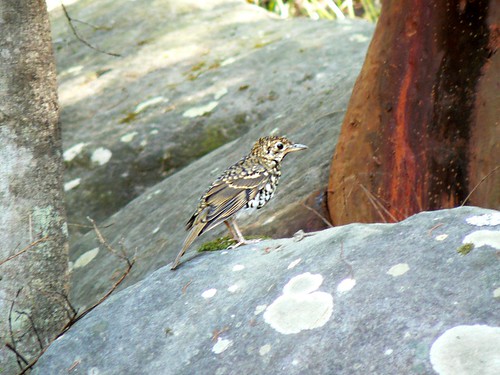 |
| Zoothera lunulata Bassian Thrush |
Acanthorhynchus tenuirostris Eastern Spinebill
Accipiter fasciatus Brown Goshawk
Alectura lathami Australian Brush-turkey
Alisterus scapularis Australian King-Parrot
Anthochaera carunculata Red Wattlebird
Anthochaera chrysoptera Little Wattlebird
Aquila audax Wedge-Tailed Eagle
Aviceda subcristata Pacific Baza
Cacatua galerita Sulphur-crested Cockatoo
Cacatua roseicapilla Galah
Cacatua tenuirostris Long-billed Corella
Calyptorhynchus funereus Yellow-tailed Black-Cockatoo
Calyptorhynchus lathami Glossy Black-Cockatoo
Corvus coronoides Australian Raven
Cracticus torquatus Grey Butcherbird
Dacelo novaeguineae Laughing Kookaburra
Eopsaltria australis Eastern Yellow Robin
Eudynamys scolopacea Common Koel
Grallina cyanoleuca Magpie-lark
Gymnorhina tibicen Australian Magpie
Leucosarcia melanoleuca Wonga Pigeon
Macropygia amboinensis Brown Cuckoo-Dove
Malurus cyaneus Superb Fairy-wren
Manorina melanocephala Noisy Miner
Menura novaehollandiae Superb Lyrebird
Myiagra cyanoleuca Satin Flycatcher
Neochmia temporalis Red-browed Finch
Ninox novaeseelandiae Southern Boobook
Ninox strenua Powerful Owl
Ocyphaps lophotes Crested Pigeon
Oriolus sagittatus Olive-backed Oriole
Pachycephala rufiventris Rufous Whistler
Pardalotus striatus Striated Pardalote
Pardalotus punctatus Spotted Pardalote
Philemon citreogularis Little Friarbird
Platycercus elegans Crimson Rosella
Platycercus eximius Eastern Rosella
Podargus strigoides Tawny Frogmouth
Psophodes olivaceus Eastern Whipbird
Ptilonorhynchus violaceus Satin Bowerbird
Scythrops novaehollandiae Channel-billed Cuckoo
Sericornis frontalis White-browed Scrubwren
Sericornis citreogularis Yellow-throated Scrubwren
Strepera graculina Pied Currawong
Trichoglossus haematodus Rainbow Lorikeet
Zoothera lunulata Bassian Thrush
Thursday, November 11, 2010
Photo competition....
Delighted to have just learned that I've won first prize in the inaugural Macquarie University Arboretum photo competition! And also delighted that the prize is $500 cash. Whoop!
Here is the image: an Angophora I walk past every day from the railway station.
Here is the image: an Angophora I walk past every day from the railway station.
Personally, the judges' choice rather surprises me, because I think that there are others among the finalists far better than this, but I am absolutely not complaining.
As you can see from all the images, the flora on the Macquarie campus is just beautiful. So much open space, wonderful landscaping, and a huge variety. Congratulations to all the other photosnappers, and thanks to the judges!
As you can see from all the images, the flora on the Macquarie campus is just beautiful. So much open space, wonderful landscaping, and a huge variety. Congratulations to all the other photosnappers, and thanks to the judges!
Friday, October 29, 2010
Aw.
I am up to my earballs in uni work/study at the moment and have been deliberately ignoring this poor forsaken blog, but couldn't resist posting this.
In our backyard, this evening.
Swamp Wallaby, Wallabia bicolor, with joey. (Happily, they were eating weeds.)
In our backyard, this evening.
Swamp Wallaby, Wallabia bicolor, with joey. (Happily, they were eating weeds.)
Friday, September 17, 2010
Department of Biology... Open Day 2010
I thought I'd play with Flickr's slideshow embedding function. Rather cool, I think!
These photos are from Macquarie University's Open Day earlier this month:
These photos are from Macquarie University's Open Day earlier this month:
- Jonno and his Eclectus parrots, Eclectus roratus. Interesting sexual dimorphism, probably related to their polygyny: the female is red, and the male green.
- Adam Stow with an Olive python: Liasis olivaceus. Adam is a conservation geneticist and my supervisor for my 2010 Advanced Biology Internship.
- Prospective students exploring geekery in one of our teaching labs.
- Queuing for fairy floss: Macquarie University Biological Society rots the teeth of prospective students.
- Pteropus poliocephalus, a grey-headed flying fox (fruit bat).
- A mantis eats a cricket.
- A couple more photos of the Olive python, including one with its very close friend Siobhan.
- Tawny Frogmouth: Podargus strigoides, doing its stump impersonation.
- Green tree frog: Litoria caerulea.
- Blue tongue lizard: Tiliqua scincoides scincoides.
- MUBS friends Eleanor and Renee with a St Andrew's Cross Spider, Argiope keyserlingii.
Saturday, August 28, 2010
Monster Rainforest Snails
I've just cleaned and photographed three snail shells that I found in the rainforest floor in Bulburin. Shortly I hope to have an identification of them, and will post the results here. In the meantime, gaze in wonder!
As you can see from the scale, these are mighty molluscs. The largest shell is 84 mm in length.
As you can see from the scale, these are mighty molluscs. The largest shell is 84 mm in length.
Friday, August 27, 2010
Adventures in a subtropical rainforest: Part 5
In the final post of this series, some mosses of the subtropical rainforest. Mosses are plants that evolved well before the flowering plants (angiosperms), conifers and ferns. They have lack a vascular system, which means that they require constant moisture to avoid desiccation. Mosses reproduce by way of spores rather than seeds and have a fascinating life cycle in which haploid and diploid generations alternate.
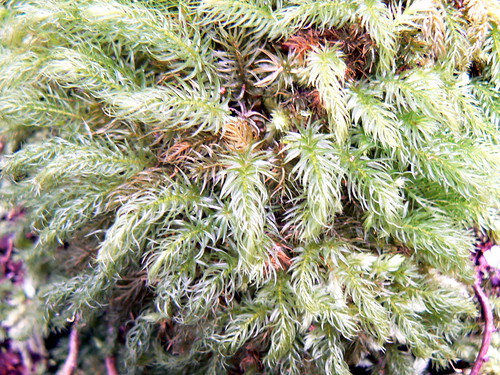

Before I sign off from this spate of posts, here's a mystery. These worms, which essentially resembled earthworms (phylum Annelida) were at around chest height. They appeared to be dead, but recently so. Any thoughts as to what they were doing there, and how they got there? I'm flummoxed!
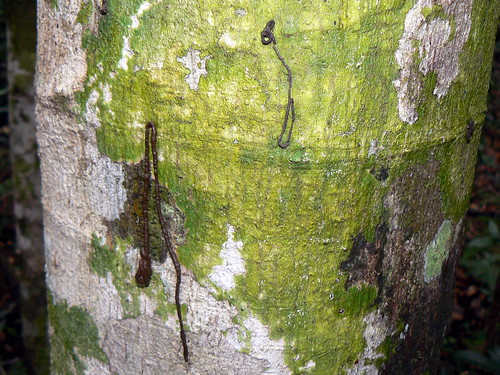 |
| Why am I here? |
Adventures in a subtropical rainforest: Part 4
The next of this series of posts on Bulburin National Park will look at some lichen I observed in the rainforest. Bryophytes and lichens have long fascinated me, possibly because once you look closely, they themselves can look like intricate forests of great complexity and beauty. The moisture level of rainforests allows them to flourish there.
This enormous Ficus sp. is covered with an array of lichens of various hues. Lichens are the result of a symbiosis between a fungus and an algae. The algae provides sugars produced by photosynthesis, and in return, the fungi supply the algae with nutrients it extracts from the substrate--in these cases, the bark of the tree.
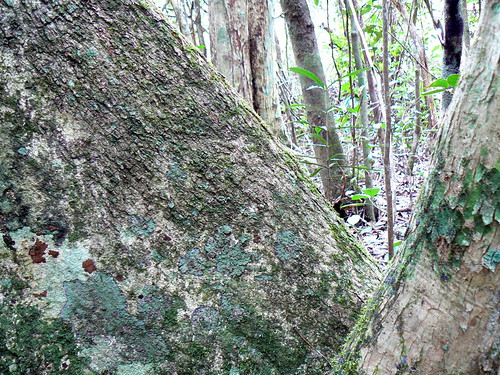
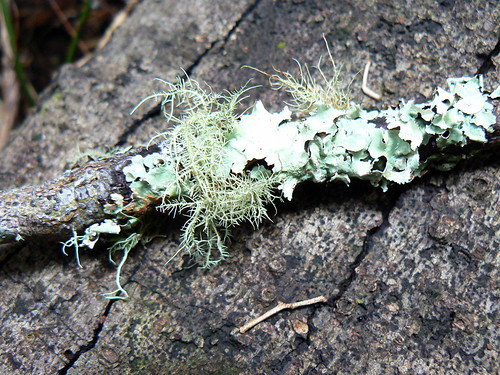
Next post: Mosses.
This enormous Ficus sp. is covered with an array of lichens of various hues. Lichens are the result of a symbiosis between a fungus and an algae. The algae provides sugars produced by photosynthesis, and in return, the fungi supply the algae with nutrients it extracts from the substrate--in these cases, the bark of the tree.


Next post: Mosses.
Adventures in a subtropical rainforest: Part 3
In this post, I'll concentrate on food. No, not the endless country pub meals of steak and chips, but the cuisine that consists of rainforest flora, both dead and alive. Of course, the substrate is alive with arthropods of huge diversity, but I wasn't digging down to find them. Insects made their appetite evident in the eaten leaves of many plants, but this is a particularly nice example of insect herbivory:
This is a beetle gallery, the result of bark beetles boring through the outer bark of the tree, then eating tunnels through the cambium layer beneath. Here the bark has been shed.
The great consumers of dead (and sometimes living) plant material are the fungi. What we see above ground or on the surface of logs are just the fruiting bodies. Beneath, there are kilometres of minutely thin filaments digesting and breaking down wood and other organic matter, converting it into a form that's usable by bacteria. Bulburin boasts some spectacular specimens.
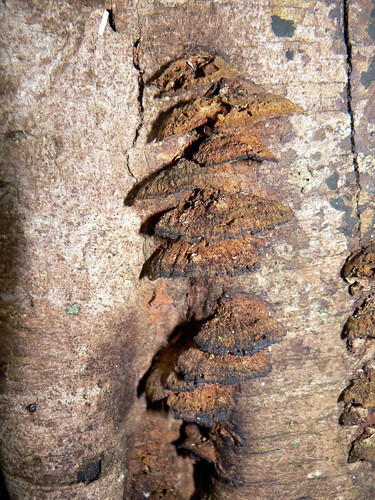
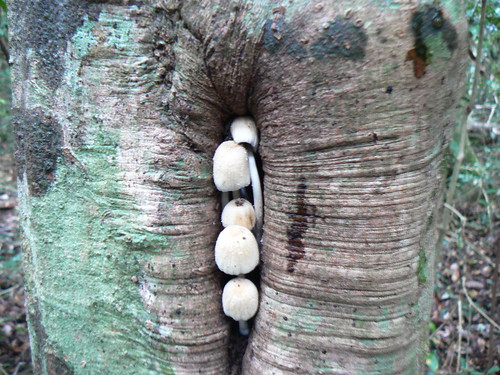
Next post: Lichen.
This is a beetle gallery, the result of bark beetles boring through the outer bark of the tree, then eating tunnels through the cambium layer beneath. Here the bark has been shed.
The great consumers of dead (and sometimes living) plant material are the fungi. What we see above ground or on the surface of logs are just the fruiting bodies. Beneath, there are kilometres of minutely thin filaments digesting and breaking down wood and other organic matter, converting it into a form that's usable by bacteria. Bulburin boasts some spectacular specimens.


Next post: Lichen.
Adventures in a subtropical rainforest: Part 2
For a politics junkie like me, finding yourself on Federal election night in a tiny Queensland outpost (pop.15, one pub, one single-cop police station and nothing else) can be somewhat of a shock. Normally I'm surrounded by like-minded Greens, browsers open on various election result sites, the TV being channel-hopped to find the juiciest snideries from the politicians commentating.
This time I was sitting with Chris Lusk in the bar of aforementioned pub (where we were staying), watching a hazy image on a small wall-mounted TV, and we were clearly the only people there even faintly interested in who the government was going to be. The jukebox was loudly accompanying the two pool players with Credence Clearwater Revival and Deep Purple, which made hearing Kerry O'Brien and Antony Green just a touch difficult.
But if the hamlet of Many Peaks feels isolated, delving into the nearby rainforest is akin to being on the dark side of the moon. Bulburin National Park is a subtropical notophyll rainforest, one of the largest remnants of rainforest in Queensland. The area around Many Peaks is schlerophyll forest, the transition to rainforest occurring as you climb the mountain.
Within metres of the road, it's easy to lose your bearings (particularly if your bearings happen to be as fragile as mine!) The forest is dense and moist, with creepers climbing up the trees and criss-crossing your path. Some are prickly, so if you lose your balance, you need to be cautious about what you grab.
The most overwhelming impression of rainforest is the rapid turnover of resources, the constant cycle of decay and regeneration. In the ferocious competition for light, plants reach up to the canopy, climbing upon each other. If a forest giant falls and allows the sunshine to stream in, hundreds of seeds will germinate in the patch exposed, fighting each other for nutrients and access to the sky above.
Everything is either food or a foothold, a place to live.
Next post: Fungi!
This time I was sitting with Chris Lusk in the bar of aforementioned pub (where we were staying), watching a hazy image on a small wall-mounted TV, and we were clearly the only people there even faintly interested in who the government was going to be. The jukebox was loudly accompanying the two pool players with Credence Clearwater Revival and Deep Purple, which made hearing Kerry O'Brien and Antony Green just a touch difficult.
As it became increasingly apparent that there would be a hung parliament, the following days were massively frustrating. No radio reception, no mobile reception, and of course, nothing even faintly resembling an Internet. To get a newspaper, we had to drive a good half hour to the nearest town--and the newspapers were out-of-date.
 |
| The road through Many Peaks, with the flood-way of Deception Creek. |
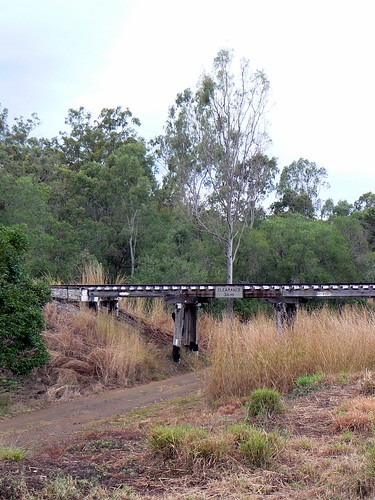 |
| Many Peaks Railway Bridge. |
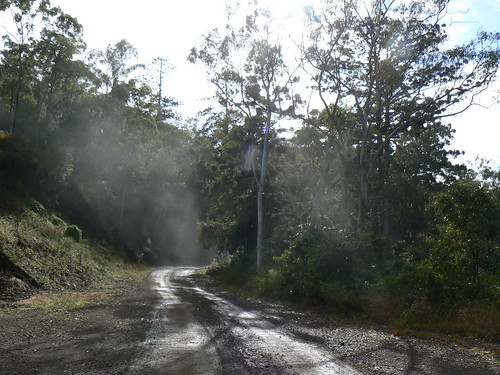 |
| The road to the rainforest. |
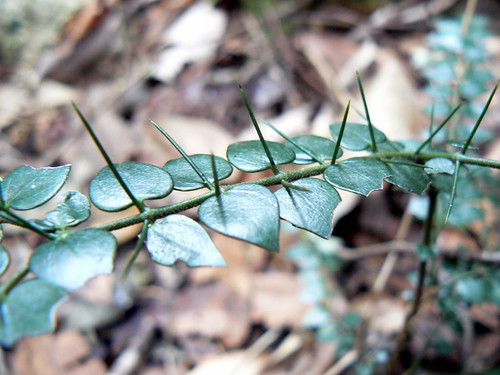 |
| Ouch. |
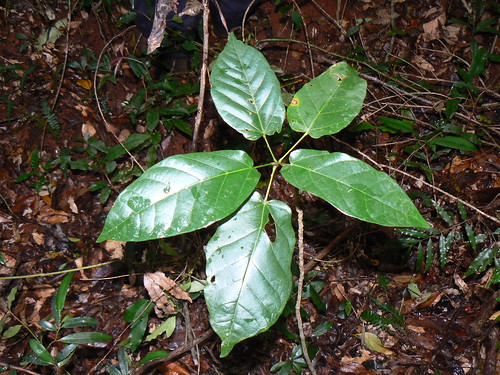 |
Extra ouch: Dendrocnide photinophylla, Giant Stinger. |
The most overwhelming impression of rainforest is the rapid turnover of resources, the constant cycle of decay and regeneration. In the ferocious competition for light, plants reach up to the canopy, climbing upon each other. If a forest giant falls and allows the sunshine to stream in, hundreds of seeds will germinate in the patch exposed, fighting each other for nutrients and access to the sky above.
Everything is either food or a foothold, a place to live.
 |
| A vine embraces a rainforest tree. |
 |
| Reaching the light. |
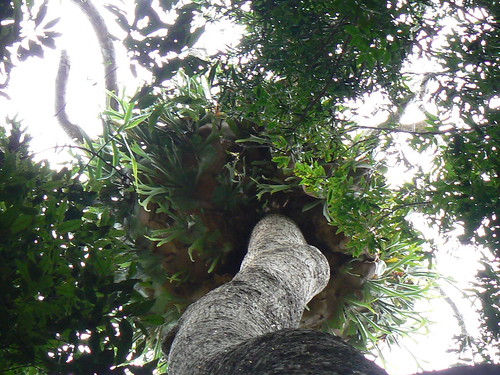 |
| An elkhorn fern (Platycerium sp.) colony atop a dead rainforest tree. |
Next post: Fungi!
Adventures in a subtropical rainforest: Part 1
Yesterday I flew home from a six day field trip to Bulburin National Park, in Queensland. It's just a touch south of the Tropic of Capricorn.
View Bulburin National Park, Queensland in a larger map
I was there as part of my role as research assistant to Chris Lusk, of Macquarie University's Department of Biology. Chris runs the Forest Ecology lab. He's researching the relationship between shade tolerance, light and growth in a range of rainforest tree species across tropical, sub-tropical and temperate rainforests in Australia and New Zealand. Later this year, we'll be visiting a temperate rainforest in South-West Tasmania.
Among the measurements we made at Bulburin was the light reaching individual saplings through the canopy. This is done by hemispherical photography, which uses a fish-eye lens and records the light obstruction by surrounding trees and shrubs. Here's an example that Chris took on a previous field trip:
When I get back to the lab, one of my jobs will be to work out the precise amount of light that reaches each of the hundreds of specimens we tagged and measured.
Over the next few posts, I'll be putting up some photos of the rainforest and surrounds. The camera very much enjoyed its workout in the bush!
Next post: The fight for light.
View Bulburin National Park, Queensland in a larger map
I was there as part of my role as research assistant to Chris Lusk, of Macquarie University's Department of Biology. Chris runs the Forest Ecology lab. He's researching the relationship between shade tolerance, light and growth in a range of rainforest tree species across tropical, sub-tropical and temperate rainforests in Australia and New Zealand. Later this year, we'll be visiting a temperate rainforest in South-West Tasmania.
Among the measurements we made at Bulburin was the light reaching individual saplings through the canopy. This is done by hemispherical photography, which uses a fish-eye lens and records the light obstruction by surrounding trees and shrubs. Here's an example that Chris took on a previous field trip:
When I get back to the lab, one of my jobs will be to work out the precise amount of light that reaches each of the hundreds of specimens we tagged and measured.
Over the next few posts, I'll be putting up some photos of the rainforest and surrounds. The camera very much enjoyed its workout in the bush!
Next post: The fight for light.
Monday, July 26, 2010
A slight move.
I've recently purchased the domain, http://growingpassion.org, replacing my old blogspot address. This doesn't have any profound impact on any links or feeds you might have to this blog, because it's automatically redirected. But I thought I'd let you know. :)
Although I've been theoretically on mid-semester break, I've actually been pretty busy doing my Advanced Biology internship in genetics, so my plans for lots of blogging have been somewhat thwarted. And tomorrow I have my first day in the Lusk Lab, which is pretty groovy.
But plans are afoot for much more writing. I'll keep you posted!
Although I've been theoretically on mid-semester break, I've actually been pretty busy doing my Advanced Biology internship in genetics, so my plans for lots of blogging have been somewhat thwarted. And tomorrow I have my first day in the Lusk Lab, which is pretty groovy.
But plans are afoot for much more writing. I'll keep you posted!
Sunday, June 27, 2010
Life on the stump.
It's now three years since a large Angophora costata in our garden fell on our roof during a storm. As it fell, its enormous roots lifted from the sodden ground, leaving what appears from the surface to be capacious accommodation for sundry creatures. When I last saw our Red Bellied Black Snake at the end of summer, it appeared to have made its home there, conveniently located adjacent to the frog pond where food abounds.
Now the wood is decaying and the fungi are clearly pleased with what they can digest from it. I just took these images of the residents.
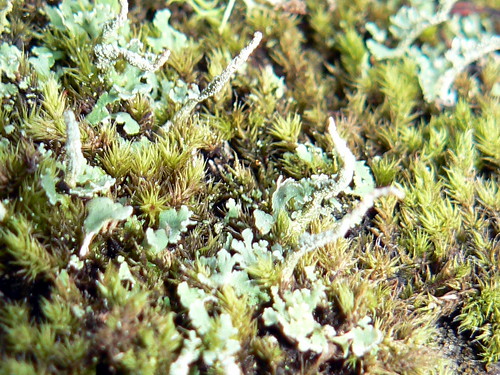
Here are moss and what I'm pretty sure are hornworts, which comprise the pale green flattened lobes and horn-like capsules in which the spores are produced.
Now the wood is decaying and the fungi are clearly pleased with what they can digest from it. I just took these images of the residents.
This is a jelly fungus, Tremella spp. It feels just as you'd expect: soft and gelatinous. Tremella are parasitic on other fungi and in this case, it's possible it's feeding on the hyphae of the next fungus:
A bracket (or shelf) fungus. I'm unsure of the species, but suspect that the green colouring might be a lichen growing on the fungus itself. Lichen is the result of a mutualistic relationship between an algae and a fungus, so if this is lichen, it's an example of two symbioses: one parasitic, one mutualistic. If anyone reading can identify the fungi and confirm if it's wearing a very fetching lichen jacket, please, let me know!
Busy place, the stump.
And on the sandstone rock next to it, another thriving ecosystem is growing:

Here are moss and what I'm pretty sure are hornworts, which comprise the pale green flattened lobes and horn-like capsules in which the spores are produced.
Monday, June 21, 2010
Heck.
I am so happy to let you know that my blog post on the evolution of chloroplasts has come third in the 2010 3 Quarks Daily Prize in Science, judged by Richard Dawkins! I am now the delighted recipient of the Charm Quark. Those of you who are regular readers will know that this is a pretty humble blog in the scheme of things. It's fantastic that 3 Quarks Daily is supporting bloggers like me who don't get huge traffic or coverage out there in the world. It should be an inspiration to everyone who taps away quietly in their garret, wondering if there's anybody out there reading.
The 3 Quarks Daily people asked me to post my acceptance speech on their site, and this is what I wrote:
The 3 Quarks Daily people asked me to post my acceptance speech on their site, and this is what I wrote:
I feel utterly charmed!
Thanks so much to the good folk at 3 Quarks Daily, to those who voted for my blog post, and of course to Richard Dawkins. I’ve been a fan of his since I first read “The Selfish Gene” back in the seventies, and knowing that he came to visit my little blog and liked what he read is both boggling and thrilling.
They say that you should write about what you care about, and that’s just what I did in posting on the evolution and genetics of chloroplasts. I’ve come late in life to biology, having spent time on a couple of earlier careers. My childhood growing up on the outskirts of Sydney with weekends pottering in the bush instilled in me a love of Australian flora, and that in turn directed me to horticulture. When I studied it, however, I realised quickly that it wasn’t going to teach me the nuts and bolts of how plants work. For that I needed a science degree and so I returned to Macquarie University. After my first lecture in my first biology unit, I knew I was absolutely in the right place.
I want to express my deep gratitude to the biology staff at Macquarie, who have been unremittingly encouraging of my passion for science and general geekiness. Without their support I’d never have had the courage to try writing about biology. In particular, thanks to Dr Adam Stow (the Genetics lecturer for whom I prepared the presentation on which the blog post is based, and who is now supervising my internship in his lab), to Associate Professor Brian Atwell (my planty mentor) and to the Head of the Department of Biological Sciences, Professor Lesley Hughes, who always seems to have time for me. And finally, my fellow student and dear friend, Julian May: thanks for the nomination!
And thanks of course to my husband, Martien and my daughter, Maxine. No one could ask for a family more tolerant and supportive of a somewhat obsessive and passionate biogeek.Congratulations to the other finalists and winners. The standard of their work is magnificent, and I feel very proud to be in their company.
Thursday, June 17, 2010
A change in season.
Exams are nearly over for the semester, and once they're finished I'll find myself in the curious position of being free of them for some time. I'm taking a sabbatical, if that is something an undergraduate is entitled to call her break from the routine of exams and assignments and lectures and pracs. Next semester, I'm only taking one unit in my degree: the final half year of 3rd Year Advanced Biology. That's primarily going to entail an internship (starting on Monday) in the Conservation Genetics Lab with Dr Adam Stow and Ph.D student (and wildlife photographer!) Paul Duckett. I'm assisting with genetic analyses of a species of tree skink. It's a great opportunity to learn more about a field that fascinates me and essential techniques of the trade. My goal is one day to use this knowledge and somehow apply it to plants and their symbionts. Not entirely sure how, yet....
I've also just been appointed to an exciting new job as a part-time research assistant with Dr Chris Lusk, starting late July. Chris is researching juvenile rainforest plants, and later this year we're off to some fabulous locations to do field work, including western Tasmania. That part of the world boasts some of the most ancient and pristine rainforests on the planet. I touched the edge of them a few years ago, on a family holiday to Tassie. It's almost impossible to express just how beautiful Tasmanian wilderness is. So I'll content myself with some photos of that trip.
The Gordon River, Western Tasmania
Huon Pine rainforest.
To return to this place with a botanist's eye is a thrilling prospect.
But almost as alluring as all this is the chance of spending more time in the garden. The Forest of Sabine is growing apace, and I'm starting to think about filling in the gaps between the trees and shrubs--and things for planting in any other spots I can find. I've been amassing seeds and once the weather warms up I'll be germinating them in the shade-house.
The seeds so far:
- Lomandra filiformis, a graceful monocot with thin, strappy leaves with a beautiful bluey-green tinge.
- Poa labillardierei, Common Tussock Grass.
- Dianella caerulea, Paroo Lily or Blue Flax-lily. It's a useful clumping monocot with small but spectacular blue and yellow flowers.
- Anigozanthus flavidus, Kangaroo Paw. This is a bit of a cheat. It's not local, but comes from Western Australia. And it needs lots of sun, so won't work in among all the other plants. But I love it, and who wouldn't? Fabulous flowers, unlike anything else you'll find.
- Elaeocarpus reticulatus, Blueberry Ash. A small tree with delicate white or pink flowers. We already have one (white flowered, as you can see), but who could resist more?
- Telopea speciossima, Waratah. We don't actually need any more of these because the Forest of Sabine is brimming with them, but I thought if I could grow a few they'd make nice presents for plant-loving friends. Here's a shot we took of one in nearby bushland.
- Callistemon viminalis, Weeping Bottlebrush. Just because they're beautiful.
Finally, I'm going to spend more time blogging about plants and science. Those nice folk at 3 Quarks Daily have inspired me!
Wednesday, June 09, 2010
3 Quarks Daily... Semifinals! (And finals!)
I've made it to the next round! Thank you so much to those who voted for my blog entry.
You can see the rest of the semifinalists here. The finalists will be announced in a couple of days, and then Richard Dawkins will judge the first, second and third prizewinners. Fingers crossed!
Edit: 11 June. Well heck. I'm a finalist!!
There are nine of us, the six who were voted by the public from all 80 nominees, plus three wildcards chosen by the judges.
This means that Richard Dawkins is going to be reading my blog post. Is it totally gormless of me to say that's one of the most exciting things that's ever happened to me since I started studying science? It is? Okay, won't say it then. (Oh, hi Richard.)
Anyway, I'll calm down now and keep working on my Plant Ecophysiology research report on the effect of sugar-stimulated soil nitrogen depletion on plant growth and soil biota. And I promise, I won't blog on it. For your sake and mine.
(Huzzah!)
You can see the rest of the semifinalists here. The finalists will be announced in a couple of days, and then Richard Dawkins will judge the first, second and third prizewinners. Fingers crossed!
Edit: 11 June. Well heck. I'm a finalist!!
There are nine of us, the six who were voted by the public from all 80 nominees, plus three wildcards chosen by the judges.
This means that Richard Dawkins is going to be reading my blog post. Is it totally gormless of me to say that's one of the most exciting things that's ever happened to me since I started studying science? It is? Okay, won't say it then. (Oh, hi Richard.)
Anyway, I'll calm down now and keep working on my Plant Ecophysiology research report on the effect of sugar-stimulated soil nitrogen depletion on plant growth and soil biota. And I promise, I won't blog on it. For your sake and mine.
(Huzzah!)
Subscribe to:
Posts (Atom)
